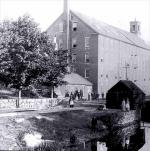Post-Civil War Stow
Sawmills, grist mills and cider mills came to Stow almost from its beginning. Textile mills came as early as 1812, when several entrepreneurs established the Rock Bottom Cotton and Woolen Company (the community name Rock Bottom came from someone shouting that a laborer digging a hole had “hit rock bottom!”).
The Rock Bottom mill operation had gone through several owners when it was acquired by businessmen Benjamin Gleason and Samuel Dale in 1848. Rebuilt following a fire in 1852, the business prospered, doing especially well during the Civil War manufacturing cloth for clothing and blankets for the Union Army. Eventually, the Gleason family bought out the Dales and the company continued under Gleason ownership well into the 20th Century.
To honor the owners whose leadership had launched it on its path to prosperity, the Rock Bottom community’s name was officially changed to Gleasondale in 1898. Today, many of the original structures remain as a village, including owners’ Victorian mansions, workers’ housing – all now private residences – and the Gleason mill. It currently serves as an industrial park.
A larger textile community developed downstream at Assabet Village, where it occupied land in both Stow and Sudbury. Businessman Amory Maynard started a carpet manufacturing company in 1847, lost it in the 1857 business panic and came back in 1862 with the Assabet Manufacturing Company, producing blankets and other woolens for the Union Army during the Civil War.
Industrial operations in Assabet Village grew to such an extent that it developed a need for town services that neither Stow nor Sudbury could meet. In 1871, Assabet Village land in both towns was chartered as the new town of Maynard, so named in honor of the entrepreneur who played a leading role in its development.
By the numbers, Stow’s population didn’t grow very much. Although it had some 1,800 residents in 1870, it lost some 800 of them when Maynard was incorporated.
Population stability suffered from another problem – the general migration of farmers from the land. As technology advanced – particularly the opening of the Erie Canal and then the coming of the railroads in the late 1840s – it became economically feasible for products from larger, more productive farms to the west to be shipped to eastern cities. Massachusetts’ small, rock-bound farms found themselves becoming less and less competitive.
Many farms were abandoned and reverted to forest. Some farmers adapted by emphasizing milk production – by 1850, the rail line from Fitchburg was transporting more than 14,000 quarts of milk from outlying towns to Boston every day. Hay was such an important crop in Stow that the town maintained a giant hay scale in front of Town Hall, enabling farmers to drive their loaded wagons on and weigh their cargo.Toward the end of the 19th Century, Stow acquired one of its central cultural resources – Randall Library. John Witt Randall was a wealthy investor, writer, naturalist – and Boston/Stow resident. Following his death in 1892, his sister, Belinda Lull Randall, drew on his fortune to present the town with gifts of $25,000 for construction of a public library and $20,000 for other town uses. Randall Library was opened in 1894.
Photos
 Gleasondale Mill- Although a textile mill was in operation at Rock Bottom on the Assabet River as early as 1813, it prospered during and following the Civil War.
Gleasondale Mill- Although a textile mill was in operation at Rock Bottom on the Assabet River as early as 1813, it prospered during and following the Civil War.
 Workers’ Housing- Worker’s Housing lined the road through the little village along with owners’ more elegant mansions. Some of each still stand and serve as private residences.
Workers’ Housing- Worker’s Housing lined the road through the little village along with owners’ more elegant mansions. Some of each still stand and serve as private residences.
 Randall Library- The sweeping arch on Randall Library’s west side, now a graceful window on the second floor, contained the building’s original main entrance. An expansion and renovation in 1975 relocated the front entrance to the first floor, on the south side. This photo shows the Library in the early 20th Century.
Randall Library- The sweeping arch on Randall Library’s west side, now a graceful window on the second floor, contained the building’s original main entrance. An expansion and renovation in 1975 relocated the front entrance to the first floor, on the south side. This photo shows the Library in the early 20th Century.
